Authors: Marcus Cowper
Tags: #Military History - Medieval
Henry V: The Background, Strategies, Tactics and Battlefield Experiences of the Greatest Commanders of History Paperback (11 page)

The battle of Agincourt, 25 October 1415
French Camp .
w W f> W.^v
kiS&fjfc&XffiiS
m&mkm
. English Camp
English Forces
1. Dismounted men-at-arms under King Henry
2. Dismounted men-at-arms under Thomas Lord Camoys
Maisoncelle ^ ^
3. Dismounted men-at-arms under the Duke of York
4. Archers on the flanks
French Forces
A. Dismounted men-at-arms under Charles d'Albret
B. Cavalry commanded by the Count of Vendome
C. Cavalry commanded by Clignet de Brebant
D. Second line of dismounted men-at-arms along with archers
and crossbowmen, commanded by the Dukes of Bar and Alengon
E. French calvary
as opposed to men-at-arms, while the French forces were much more
traditionally based upon the heavily armoured men-at-arms as the centre
point of their fighting force.
The French system of command and control was by no means as clear cut
as that of the English, with the advance guard commanded by Constable
d'Albret and Marshal Boucicaut along with the Dukes of Orleans and Bourbon,
as well as the Counts of Eu and Richemont. The main body was under the
Dukes of Bar and Alengon and the Counts of Nevers, Vaudemont, Blaumont,
Salines Grand-pre and Roussy, the rearguard under the Counts of Dammartin
and Fauquembergue, while the forces on the flanks were led by the Count of
Vendome and Clignet de Brebant. This complexity of the command structure
led to French commentators blaming it for the defeat that followed, as
described by the anonymous monk of Saint-Denis:
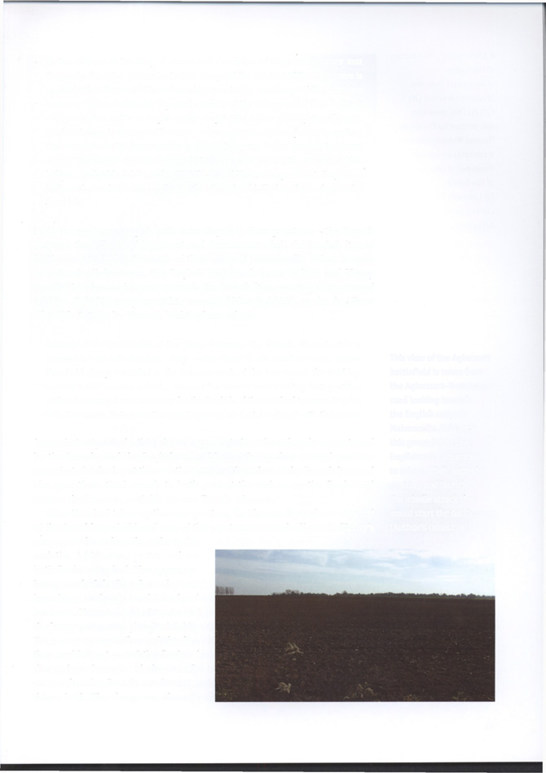
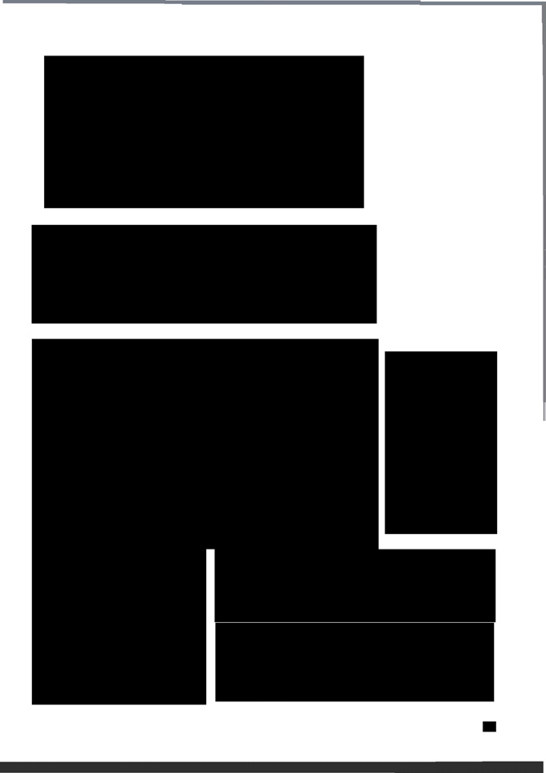
In the absence of the king of France and the dukes of Guienne, Brittany and
Burgundy, the other princes had taken charge of the conduct of the war. There is
no doubt that they would have brought it to a happy conclusion if they had not
shown so much disdain for the small number of the enemy and if they had not
engaged in the battle so impetuously, despite the advice of knights who were
worth listening to because of their age and experience... When it came to putting
the army into battle formation (as is always the usage before coming to blows)
each of the leaders claimed for himself the honour of leading the vanguard. This
led to considerable debate and so that there could be some agreement, they came
to the rather unfortunate conclusion that they should all place themselves in the
front line.
With the armies arranged, both sides stayed in their positions - the French
between the villages of Agincourt and Tramecourt while the English line of
battle was situated just outside of their camp at Maisoncelle. When it came
to a stand off, however, the English had much more to lose and Henry
decided to advance his men towards the French line, moving from around
1,000m (3,280ft) away to within around 300m (1,000ft), as the
St Albans
Chronicle
written by Thomas Walsingham relates:
Because of the muddiness of the place, however, the French did not wish to
proceed too far into the field. They waited about to see what our men, whom
This view of the Agincourt
they held cheap, intended to do. Between each of the two armies the field lay,
battlefield is taken from
scarcely 1,000 paces in extent... Because the French were holding their position
the Agincourt-Tramecourt
without moving it was necessary for the English, if they wished to come to grips
road looking towards
with the enemy, to traverse the middle ground on foot, burdened with their arms.
the English camp at
Maisoncelle. It is over
Somewhat surprisingly, this advance appears to have been largely uncontested this ground that the
by the French, and the English were able to take up their second position English army advanced
unmolested, which put them within range of bowshot of the French line and to take up their second
also gave them thick woods to both protect the archers on the flanks and position and launch
narrow the frontage available for any French advance.
the missile attack that
Once they had taken up this new position, Sir Thomas Erpingham, steward would start the battle.
of the Royal household and one of the most experienced officers in Henry's (Author's collection)
army, gave the archers the order to fire
and the 5,000 men, positioned on
both flanks, complied. This appears to
have provoked the French cavalry into
launching a charge at the archers'
positions. However, a combination of
the heavy going over ploughed fields,
the incessant arrow fire and the fact
they couldn't get round the flanks of
the archers because of the woods
meant that the French cavalry were
driven back. The charge was also not
31
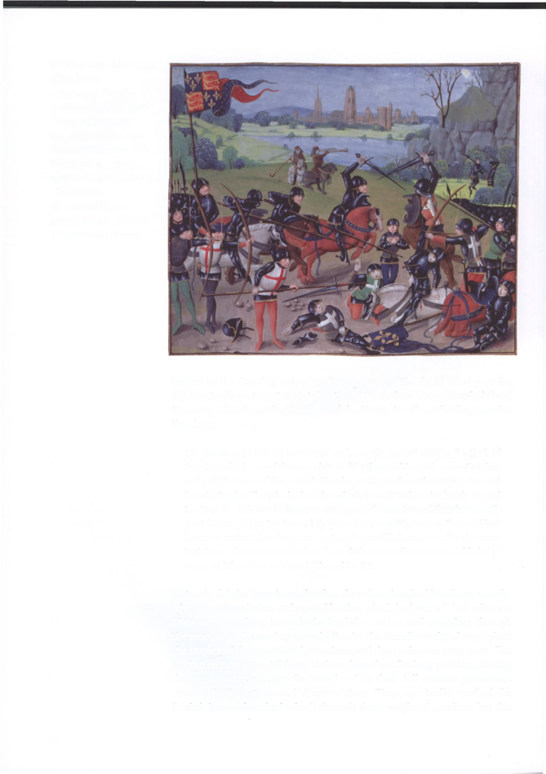
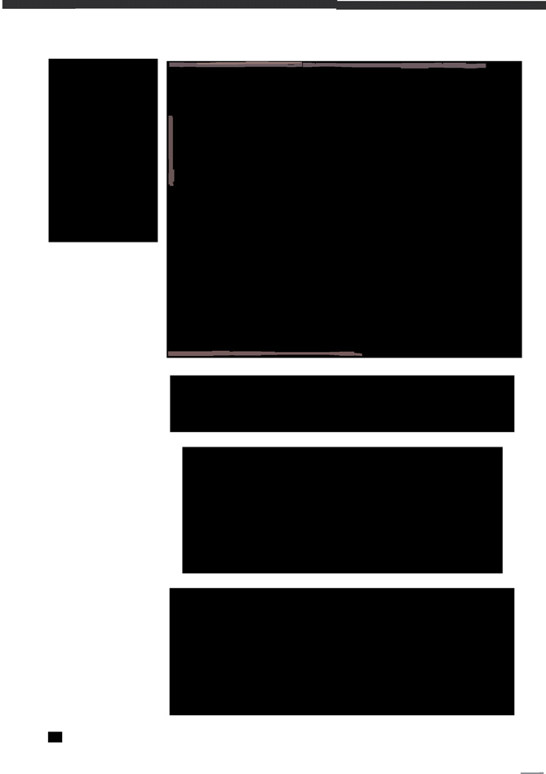
A 15th-century illustration
of the battle
of Agincourt from the
StAtbans Chronide
(Ms 6
f.243). This chronicle
was written by the mon k
Thomas Walsingham and
it contains an accurate,
if somewhat thin, account
of the battle.
(© Lambeth Palace
Library, London, UK/The
Bridgeman Art Library)
helped by the fact that only a small proportion of the 2,400 cavalry on the
flanks actually participated in it, less than 500, so there was no weight behind
the move. The chronicler Jean Juvenal des Ursins describes what happened to
the charge:
The French were heavily armed and sank into the ground right to the thick of
their legs, which caused them much travail for they could scarcely move their legs
and pull them out of the ground. They began to march until arrowfire occurred
from both sides. Then the lords on horseback, bravely and most valiantly wanted
to attack the archers who began to aim against the cavalry and their horses with
great fervour. When the horses felt themselves pierced by arrows, they could no
longer be controlled by their riders in the advance. The horses turned and it seems
that those who were mounted on them fled, or so is the opinion and belief of
some, and they were very much blamed for this.
Not only did the French cavalry flee, they also ploughed headlong into the
advancing French first and second battles, which had started their advance.
They were marching towards the English position and struggling through
the mud, now churned up even further by the French cavalry charge, when
the impact of the retreating horse disrupted their cohesion even more. The
English archers were still firing at them from their flanking positions, forcing
the men-at-arms to stay 'buttoned up' in their full armour protection,
causing further stress and disorientation. They eventually reached the
English line and pushed it back through sheer weight of numbers, but this
32
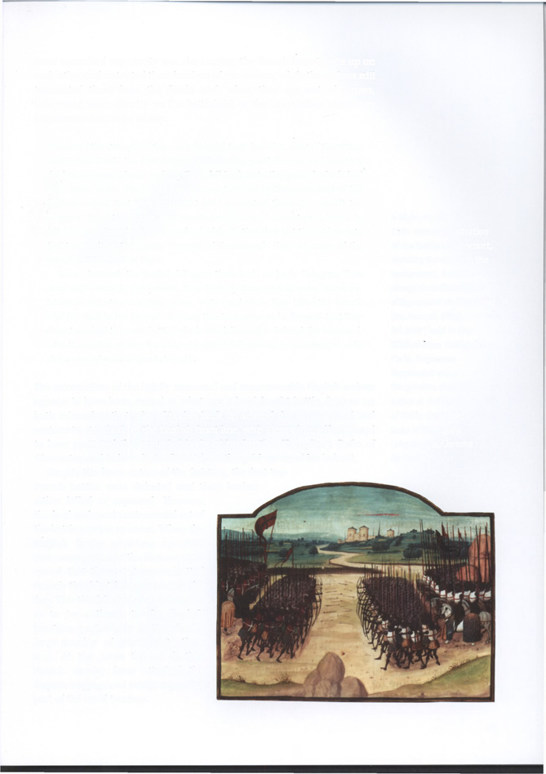

same numerical superiority was also causing the French lines to pile up on
each other and restricted their freedom of movement, while the archers still
tormented them from the flanks and, when they ran out of arrows,
intervened more directly on the battlefield, as the Burgundian chronicler
Enguerran Monstrelet relates:
Because of the strength of the arrow fire and their fear of it, most of the others
doubled back into the French vanguard, causing great disarray and breaking
the line in many places, making them fall back onto the ground which had
been newly sown. The horses had been so troubled by the arrow shot of the
English archers that they could not hold or control them. As a result the
vanguard fell into disorder and countless numbers of men-at-arms began to
A highly stylized
fall. Those on horseback were so afraid of death that they put themselves into
